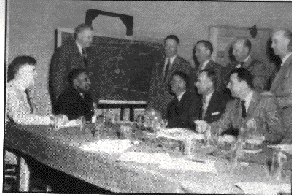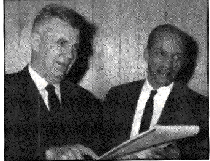BLACK COLLEGE SPORTS | home
back to The Beginning...
The History & Legends of Black College Sports | Untitled | Baseball | Football | Basketball Pt II | Legends | Product 4
Basketball Pt II
Part II
The Will to Win...
The word spread throughout the college ranks like wildfire. Black Colleges were going to play in the national tournament!
Oh yeah.
Which one?
For two years after the proclamation had passed, Executive Secretary Mack Greene attended every meeting of the NCAA and NAIB lobbying and gathering support for inclusion of Black colleges. It became apparent that the organizations could no longer ignore the growing pressure, and would have to set a precedent.

Mack Greene & the members of the1951-52 NAIA Executive Committee
Walter Byers, the longtime Executive Director of the National Collegiate Athletic Association was being pressed by his white constituents who backed the old guard, to resist the forces. Heated conversations erupted daily, with ever present threats of resignations and recessions from the staunchest opponents of integration.
Bowing to the pressure, Byers sent a message to the Black College Coaches National Steering Committee that while he respected the aggressiveness of their efforts, he would appoint certain (willing) members to address their issues, but they (NCAA) was not in a position to take on any black colleges into their tournament.
Coach McLendon, as he became affectionally known, recalled the NCAA's statement declared, "that it had no championship setup that would accommodate black college. In fact, they argued that small schools could not be included, period. We were, in fact, all relegated to 'small college' status. They were afraid that their fans would not accept or appreciate the kind of games you (Negroes) play...besides, your coaches may not be competent enough."
A New Ally
It was a resounding blow. Shaken, but not undued, they turned to the other group...the NAIB (later renamed the NAIA) and their newly named Executive Secretary, Al O. Duer.

Al O. Duer and Coach McLendon
The NAIB had been concerned with this dilemma for quite a while. As the oldest and largest intercollegiate basketball tournament at that time, they had formed in 1937 under founders Emil S. Liston, Frank Cramer, and the inventor of the game, Dr. James Naismith.
(Dr. Naismith had strong ties with Coach McLendon, his one-time student at Kansas University (see Legends). It was their vision to create a national forum for the college game. They lobbied the citizens o Kansas City to host the tourney and it has been a permanent fixture every since.)
So, the cycle was completed when the Steering Committee, with McLendon aboard, sat down with Mr. Duer and presented their case. Duer recanted the history of the league as it developed it's referendum: It declared itself a "democratic" organization but preferred its participants to be white only. It was an undeclared rule that black participation was not to be.
The war years brought on a clamoring for racial change that saw President Harry Truman strike down segregation in the armed forces. Sports would be the next setting to follow, with Jackie Robinson swinging away at professional baseball's color line.
In 1946, in the first postwar NAIB tourney, the line in college ball was breached when Morningside College in Iowa, brought a "colored" player, Rosalind Wilson to Kansas City. However, he was forced to sit and watch as his team was defeated.
Duer , then the athletic Director at Pepperdine University in California, met with Secretary Liston to declaim the unfairness of the ruling. They would meet with members of the southern districts but were soundly ignored.
The next year, Manhattan College of New York City declined an invitation to play in Kansas City because they were opposed to the discrimination of black players, even though they had no black players on their team!
Under heavy pressure from the Olympic Committee chairman, Louis G. Wilke to consider the seriousness of jeopardizing their (NAIB) participation in the 1948 Olympic Trails, the Executive Committee rescinded. By a 7 to 2 vote, black players were going to be allowed to play in the tournament.
John Wooden's Indiana State University team had the distinction of having the first black player, Clarence Walker, to step foot on the court in the tournament.
Mr. Duer, who took up the cause of the Steering Committee had kept his word. He would go on to play a vital role in the crusade.
The gate was opened.